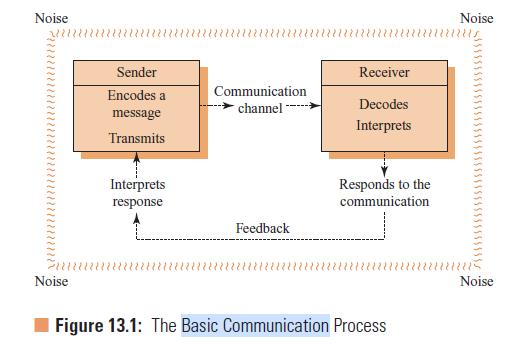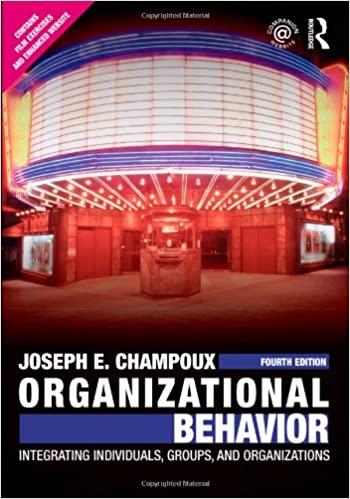Review the description of the basic communication process presented earlier in this chapter. Discuss the effect of
Question:
Review the description of the basic communication process presented earlier in this chapter. Discuss the effect of noise on the process. What forms of noise have you experienced?
THE BASIC COMMUNICATION PROCESS
Figure 13.1 shows the basic communication process. The sender decides what message to send and encodes it using symbols that he assumes the receiver will understand. The sender converts the message to a signal and transmits the message over a communication channel to the receiver. The channel can be a person’s voice, an electronic device, a written medium, or a video medium. The receiver decodes the received message and interprets its meaning. The receiver responds to the message by acting consistently with that interpretation. You use the basic communication process whenever you send an e-mail to a friend. You are the sender, your friend is the receiver, and the channel is the electronic method of transmission.
Modern communication media provide senders many choices. Senders can choose to use tele-phones, e-mail, letters or memo randa, videoconferencing, and face-to-face meetings. The criteria for choosing a medium vary. Senders can use written media for formality and a clear message and face-to-face meetings to convey a sense of teamwork. E-mail use, however, is largely based on availability and ease of use.
The feedback loop at the bottom of the figure implies interdependence between the sender and receiver during the communication process. The sender interprets the receiver’s response and can send an additional message for clarification.
Noise surrounds the entire communication process in organizations and can make communication less effective. Various distortions, errors, and foreign material often affect the quality of the signal. The noise shown in the model represents these distortions; they are additions to the signal not intended by the sender. You can illustrate this for yourself by tuning a radio to a distant station. The static you hear is noise in the communication channel. The static makes it hard for you to understand the radio message. A later section discusses communication dysfunctions that result from the presence of noise.
Workforce diversity introduces other forms of noise. The different worldviews that come from the backgrounds of a diverse workforce can prove troublesome to some people. If the receiver stereotypes a sender as ignorant because of the way he speaks, the receiver likely will distort the message. Senders with English as a second language also might not speak like native speakers, causing some receivers to distort or ignore the message.
A person’s accent can also add noise to a communication interaction. The large regional differences in accents throughout the United States can distort communication for some receivers. The same is true for people interacting with call center technicians who are outside the United States. Noise from accents also appears in languages other than English. Telemundo, the Spanish-language television network, trains its telenovela (soap opera) actors to speak an accentfree Spanish. The actors come from all over Latin America and normally speak Spanish with regional accents. Telemundo’s accent-free approach reduces noise for its largely Mexico-born and Mexican American audience (receivers). International diversity can also add noise. Korean culture, for example, values a stern, strict demeanor. This cultural value makes it difficult for Koreans to smile when providing service. The Korean Air Service Academy in Seoul, South Korea, offers smile training to companies that want to present a warm, friendly service experience.
Step by Step Answer:

Organizational Behavior Integrating Individuals Groups And Organizations
ISBN: 9780415804646
4th Edition
Authors: Joseph E. Champoux





